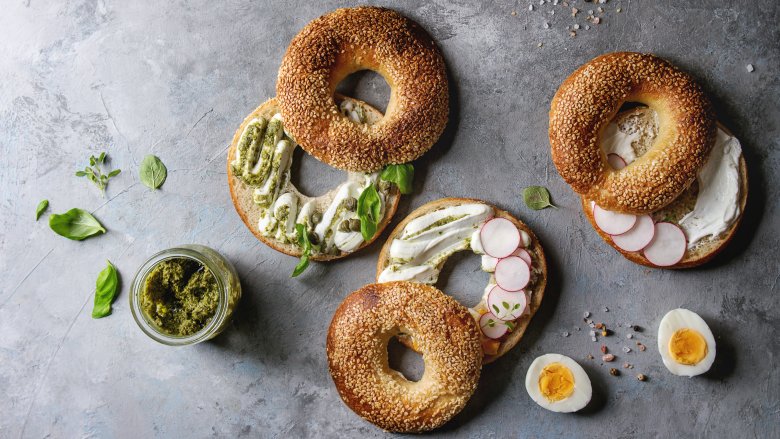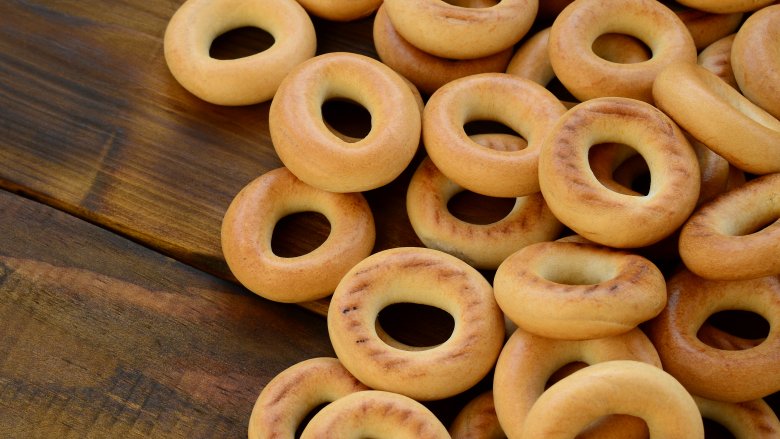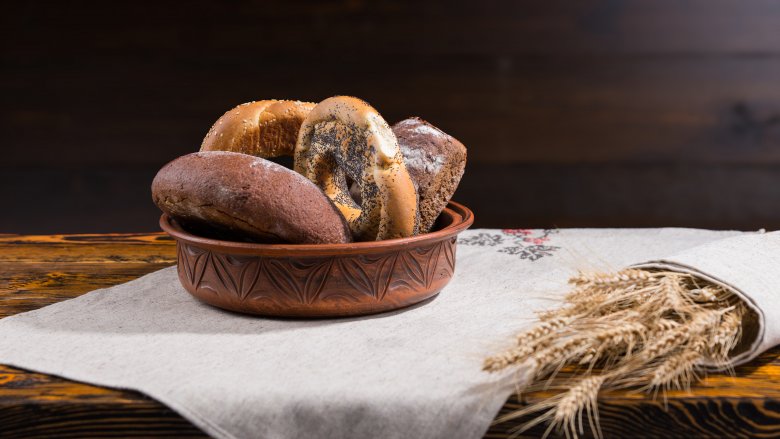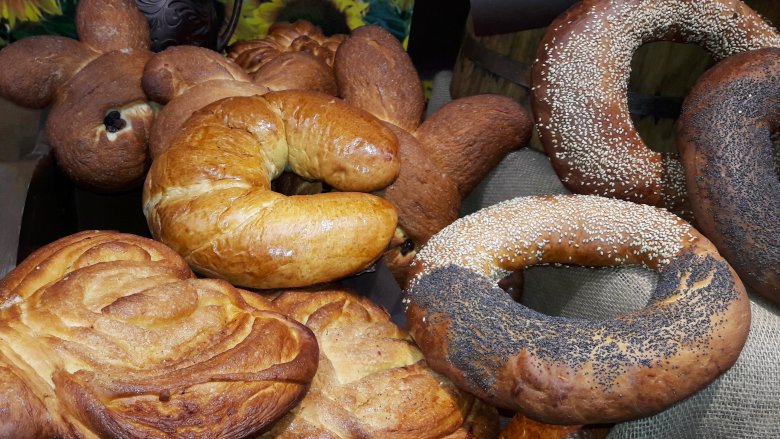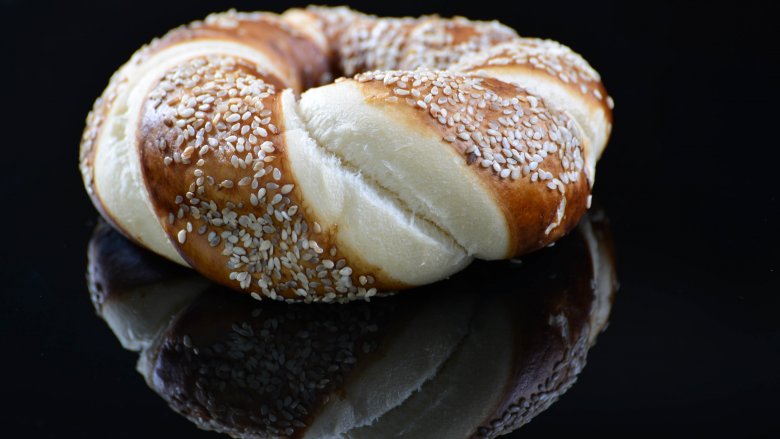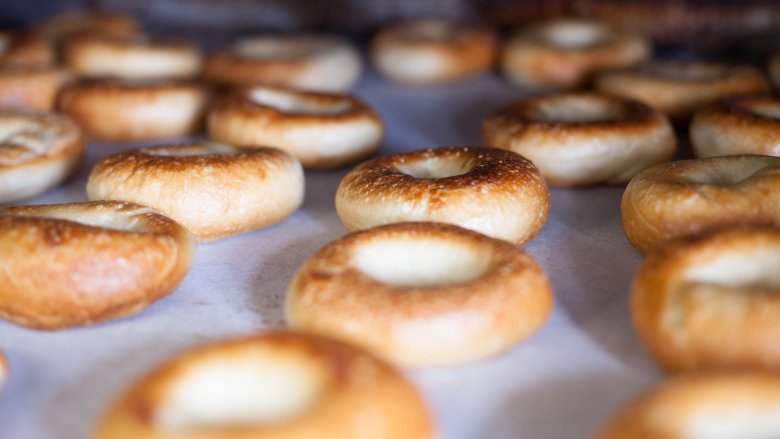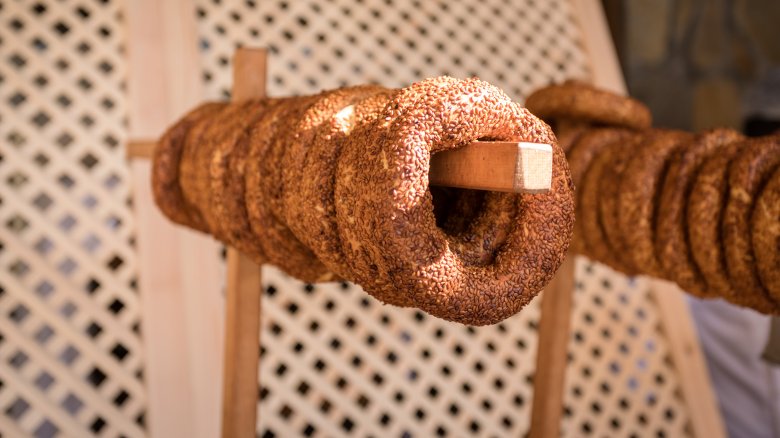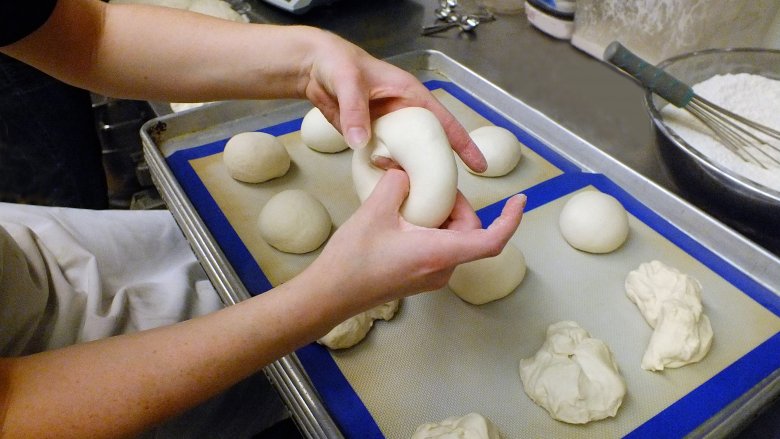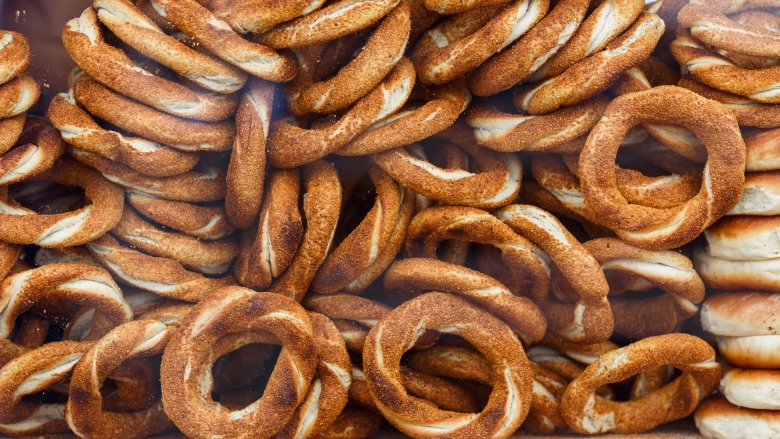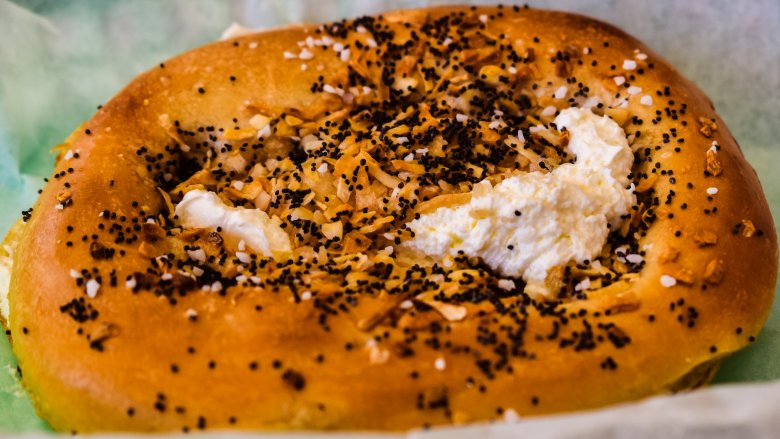The Real Reason There Are Holes In The Middle Of Bagels
Bagels. They only contain a few ingredients, but they're fairly complicated to make. They're completely unlike most other types of bread: chewy on the inside, chewier on the outside, boiled and baked to perfection, and, of course, sporting that hole in the middle.
What's with that hole, anyway? It seems like something of a waste, and that putting more bagel in there would be the way to go. It would make pizza bagels easier, for sure, along with bagel breakfast sandwiches and, well, pretty much all things bagel. Highly impractical? Maybe, but there's some incredible history behind that hole. More than that, there's some very cool mythology, too — tales told about just why a bagel is shaped like it is.
Sure, there's a very practical reason for it, too, but that's just a small part of what makes a bagel a bagel. Bet you had no idea there was so much to the story of the bagel hole, did you?
They probably appeared when they turned from pretzels to bagels
History is a funny thing, and can sometimes call for a little bit of detective work — especially when it comes to tracing the roots of cultural treasures like bagels. According to Maria Balinska, historian and author of The Bagel: the Surprising History of a Modest Bread (via The Atlantic), there's one theory about the origins of bagels as we know it that suggests they came from 14th century German immigrants moving to Poland. She says that the Germans brought traditional pretzels with them, that then turned into a more rounded roll with a hole in the center.
They were called obwarzanek, and they got a huge boost in popularity thanks to Queen Jadwiga, a massively powerful Polish monarch who not only shifted the balance of power in 14th century Europe (via Britannica) but who was also canonized by Pope John Paul II. She chose to eat obwarzanek rather than rich pastries during Lent, helping to secure their popularity as a mainstream sort of bread.
To differentiate from "Christian bread"
At the same time German immigrants were settling in Poland, Jewish immigrants were settling there, too. According to Dr. Yvette Alt Miller (via Aish), it was also a time when Jews weren't allowed to make bread, as it was seen as a holy Christian food. It wasn't until 1264 that the Polish Prince Boleslaw the Pious rescinded the laws, and declared that Jews would be allowed to "buy and sell and touch bread just like Christians".
It was a huge step, but the Church wasn't as keen on the announcement as the more secular world was. Rumors started to spread that Jewish bakers were poisoning their bread, and that Christians shouldn't buy bread made by a Jew.
Fast forward a bit, and you'll find a new ruling — Polish Jews won the right to make bread... as long as it was boiled, not baked. The goal was to differentiate it from Christian-baked bread, so Jewish bakers developed the distinctive, unmistakable, round bread with a hole in the center. It's believed by some that this tradition is where the name "bagel" came from, citing a likelihood it came from the Yiddish word beigen, or "to bend".
Made to honor a king?
Like a lot of things in history, it's not 100 percent clear-cut as to exactly when these holey rolls started popping up in a form we'd recognize as bagels, and there's another story as to exactly when they were first made and how they got their name. This one comes from central and eastern Europe as well, and the story goes that in 1683, Jan Sobieski led a massive army against Turkish forces advancing on Vienna. He repelled the Turks, says Britannica, and as thanks, a Viennese baker created a type of bread in his honor.
Maria Balinska, historian and author of The Bagel: the Surprising History of a Modest Bread (via The Atlantic), says that was the beugel. The bread wasn't baked in any traditional shape, and instead, the baker decided to pay tribute to his savior-king's love of horses. The dough was baked in the shape of a circle — designed to look like a stirrup — and then was named after the German word for stirrup. Hence, the bagel was born. Or, was it?
A symbol of eternity
Bagels have always been associated with central and eastern Europe, and particularly, with those of the Jewish faith. According to My Jewish Learning, the word "bagel" means "bracelet" in German, and that's a clear reference to the shape of this chewy, delightful delicacy. They say that the bagel may have had its roots elsewhere, but it really became popular in the Polish shtetl.
A touch of Polish and Jewish history is necessary to explain this one... A shtetl, they say, is exactly what the Yiddish words translates as: "little town." During the 19th and 20th centuries, the shtetls of Russia and Poland were small towns where Jews lived in the center, and Gentiles lived on the outskirts. Most of these communities were filled with religious figures, scholars, and artisans, and their streets were also filled with vendors selling bagels.
It was no joke, either. Bagel vendors had to have a license, and even though children would occasionally sell bagels to help support their families, it would earn them a beating if they were caught by law enforcement. Bagels were more than just bread, too. It was a common belief that their circular, never-ending shape symbolized the equally never-ending circle of life and death. Their unique shape was also thought to protect against the evil eye, and to bring good luck; that was especially true when it came to births, and they were commonly given to women in labor.
But there's a very practical reason, too
The history of the bagel and its hole is pretty incredible, but it's not just about history. According to The Bagel Bakery, there's a very practical reason that hole has stayed in bagels for centuries.
Anyone who has ever tried to make their own bagels knows that the dough is very, very thick and very heavy. That makes it difficult to cook all the way through, and that hole actually adds more surface area and helps it cook more evenly. It also makes it easier for bakers to confirm their bagels are cooked all the way through, and that's important. No one wants an underdone bagel.
They also say that the hole allows the bagel to have more of that distinctive, chewy crust that makes a bagel, well, a bagel. It turns out that it's not just one of those things that has hung around forever just because of tradition. This time, tradition is both practical and delicious, too.
The hole is the reason they're sold that way
Bagels were once sold by vendors who would thread them on long poles and carry them through the streets that way, and that's given rise to the belief that the holes were there to make it easier for vendors to carry. But historian and author Maria Balinska spoke with The New York Times and debunked that theory, saying that the holes definitely predate this tradition.
She says that well into the 1970s, bakers in New York City would thread their bagels onto ropes in order to deliver them to delis and markets around the city. You know, in the days before strict rules and regulations when it comes to food packaging and handling.
Balinska also adds something neat to the question of just what the hole means. When you first get your bagel, that hole in the middle represents a finite space in the center of the circle. As you eat it — and finish your bagel — you turn that hole into a part of the infinite, undefined space that surrounds us all. Who would have thought something that philosophical would come out of a bagel?
There's a surprisingly easy way to make the holes
Once you have real, fresh bagels out of an actual bakery, those bagels in the store just won't cut it. Depending on where you live, it might be hard to find really good bagels, but there's good news: You can make them at home, and it's not even that difficult. Time consuming? Yes. But difficult? No.
There might be a lot of steps, but you only need four ingredients, according to King Arthur Flour: flour, water, salt, and yeast. Adding the hole in the middle might seem like the most intimidating part, but there's such an easy way to do it, you'll start to wonder why you haven't made your own bagels more often. Instead of rolling out your dough, form it into balls. Once it's risen, poke your thumb through the center, put two fingers inside, and gently stretch it out. Keep in mind that the hole is going to shrink as the dough relaxes, so stretching a 2-inch hole in the center will leave you with a 1-inch hole for your finished product. Brilliant and simple, right?
Some are bigger than others
When Jews emigrated from Poland to North America, bagels went with them. For a long time, they were pretty exclusive to Jewish communities, but here's a weird footnote to the already strange history of putting holes in bagels: Not all bagel holes are created equal.
There are two types of bagels that have a much, much larger hole than the more traditional bagels, and really only started gaining in widespread popularity in the 1960s. Montreal bakers tend to make their bagels a little different — they add honey to the water before boiling to make a sweeter bread, they shape them to have large holes, and they also bake them in a wood-burning oven. According to Aish, those larger-than-normal holes can be seen in one other place: Jerusalem. There, you can still find bagels hanging from long wooden sticks in bakeries, just like they used to in the Old Country.
And there is a huge difference between these old-school bagels and the new bagels: While those holes used to be formed by hand, that's not usually the case anymore with most mass-produced, machine-rolled bagels. In 2011, Time called the commercialization of the bagel "a symbol of assimilation at any cost."
A bagel without a hole…
So, is there such a thing as a bagel without a hole? Absolutely, and it's called a bialy. The Atlantic called it the "bagel's lesser-known cousin," and that's pretty accurate.
The crust of a bialy is traditionally a little more crusty than shiny, but it does tend to have the same chewiness that a bagel does. Instead of the hole in the center, there's an indentation that helps to keep all the toppings in place. And, there's one other massive difference between the two: A bialy isn't boiled before it's baked.
But, that said, anything you can do with a bagel, you can do with a bialy. Spread them with butter, with cream cheese, add some lox, or make pizza bialys — just remember that if you want to be traditional about it, don't slice it. You don't need to, as the crust is much easier to chew than that of a bagel. But is it better? Try it and find out. Maybe the hole makes all the difference.
